Dioscorea sylvatica
Dioscorea sylvatica Eckl.
Family: Dioscoreaceae
Common names: forest elephant’s foot, forest tortoise plant, elephant’s foot yam, wild yam (Eng.); olifantsvoet, skilpadknol (Afr.); nakaa, usikolipati (isiXhosa); ufudu, ingwevu, intane, lwehlathi (isiZulu)
Introduction
Dioscorea sylvatica, commonly known by the name of wild yam, is a slow-growing, caudiciform plant that has an interesting structure which gives it great visual appeal, often referred to as an elephant’s foot or tortoise plant.

Description
Description
A slender, twining, herbaceous vine with an annual stem that grows from an enormous, tuberous rootstock, and is thus often referred to as a caudiciform plant. The fleshy, tuberous rootstock is usually situated below the soil surface or exposed above ground if growing in rocky areas. The underground tubers are dark brown and corky, with reticulated markings resembling elephant skin or a tortoise shell. The tuber is often irregularly lobed and flattened to form a low dome shape. A large tuber of Dioscorea sylvatica can be 600 to 900 mm in diameter.
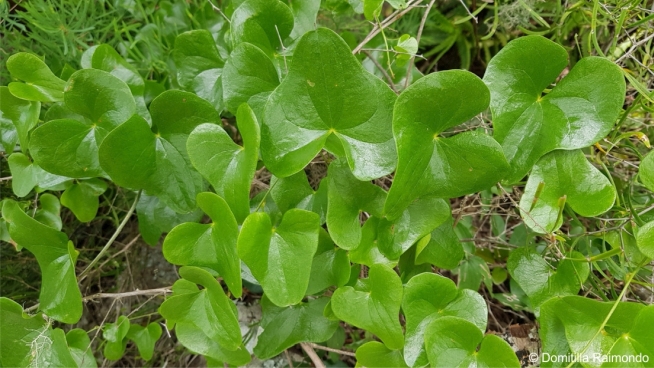
One or two twining stems emerge at the growing point on top of the tuber, and can grow up to 4 to 5 m long in a growing season. The leaves are deciduous, alternate, heart-shaped, narrowing with a long point to the apex.

The male and female flowers are found on separate plants. The flowers are small, yellowish green or yellowish cream and are produced in spikes up to 140 mm long in summer (November to April). Fruits develop on the female plants, they are yellowish green, 3-winged capsules with reddish brown edges, that split to release winged seeds.
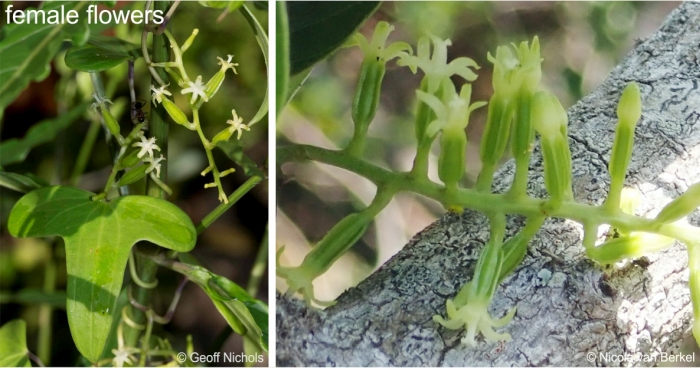
Conservation Status
Status
The conservation status of Dioscorea sylvatica is Vulnerable (VU) and declining according to the Red List of South African plants, this is because the species has been heavily exploited for its medicinal properties. A large population decline occurred from 1955 to 1960 because of indiscriminate commercial harvesting for diosgenin, a substance that was used to manufacture cortisone and other steroid hormones. It is estimated that between 116 000 and 380 000 mature individuals were removed from wild populations. Exploitation of tubers for the traditional medicinal plant trade is ongoing and is preventing recovery. Heaps of these species are seen drying out on the pavements at the traditional medicine markets all over the country.
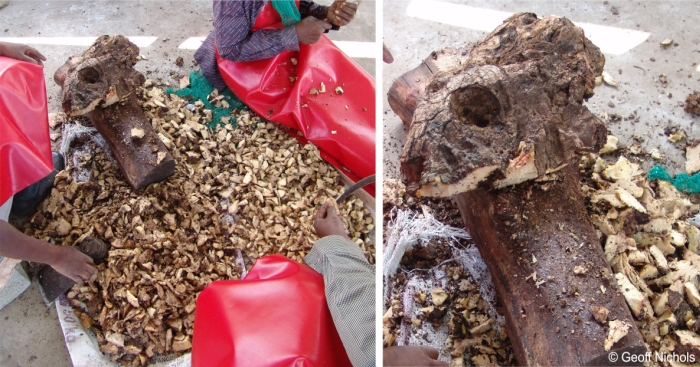
Distribution and habitat
Distribution description
Dioscorea sylvatica is found in South Africa and in Swaziland, Zimbabwe, Mozambique and Zambia. In South Africa it occurs from the Knysna area in the Western Cape through the Eastern Cape, KwaZulu-Natal, Free State, Gauteng, Mpumalanga and Limpopo Provinces. It grows predominantly in moister bushveld areas, forest margin, bracken or ericoid scrub, Albany thicket, fynbos, grassland, savanna, coastal bush and wooded mountain kloofs. It occurs from the coast to the mountains, at an altitude ranging from 125 to 1 650 m above sea level.
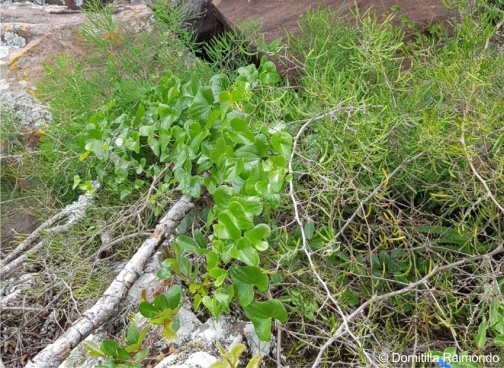
Derivation of name and historical aspects
History
Dioscorea is a genus of over 600 tuberous species that naturally occurs in the tropical and warm-temperate regions, 15 species are found in South Africa of which 12 are endemics. Almost all species have perennating organs such as a rhizome or tuber. The genus Dioscorea is named in honour of Pedanios Dioscorides who was a Greek author, botanist, physician and pharmacologist who lived in the first century AD. The species name sylvatica means ‘growing in woods’ or ‘forest loving’.
Dioscorea sylvatica has faced many name changes in the past. The plant was named in 1830 by Ecklon, but it was transferred to the genus Testudinaria by Kunth in 1850. In 1924 Knuth reduced Testudinaria to a subgenus of Dioscorea. In 1952 Burkill divided the section Testudinaria into three species, one of which was D. sylvatica. In 1953 Rowley restored Testudinaria to generic rank and it became T. sylvatica again and included D. hederifolia, but this change was not adopted. There is a need for a re-evaluation of infrageneric classification of genus Dioscorea using molecular and micromorphological data as indicated by recent cladistic analyses.
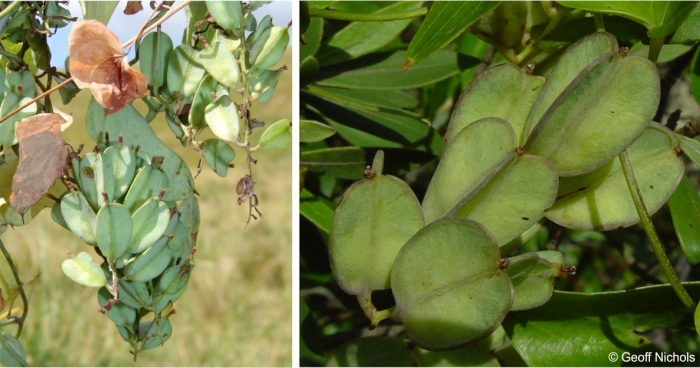
Ecology
Ecology
Dioscorea sylvatica is a monocotyledonous plant, typically dioecious meaning that male and female flowers are borne on separate plants, and it is dependent on cross-pollination for successful fertilization. It is deciduous, the leaves drop, the stems die and the plant becomes dormant during winter. The thick, corky layer covering the tuber normally protects it from veld fires and against predation. Pressure of pastoral grazing that is changing the micro-habitat of the bush also contributes to the recovery and regeneration rate of this species.
Uses
Use
Dioscorea sylvatica has long been known by Africans prior to European exploration and has been used to a limited degree as food and medicine. Plants in the genus Dioscorea contain dioscorine which is a characteristic alkaloid. Dioscorea sylvatica is used traditionally as a blood purifier, charm, a cure for skin problems caused by allergies, inflammations, and wounds or cuts. Xhosa people scoop out the tuber, heat it in water and apply the moist mixture to cuts and sores on both humans and animals. In the 1950s Dioscorea sylvatica and other species of Dioscorea were extensively harvested, nearly to extinction, for the extraction of diosgenin, a compound used to make cortisone. The drug was used for the treatment of rheumatoid arthritis and related rheumatic diseases, acute rheumatic fever, bronchial asthma, inflammatory eye diseases and various skin disorders.
Dioscorea sylvatica can be used as an unusual decorative container plant and is suitable for dry, well-drained gardens. The annual climbing stem can be supported by a trellis.
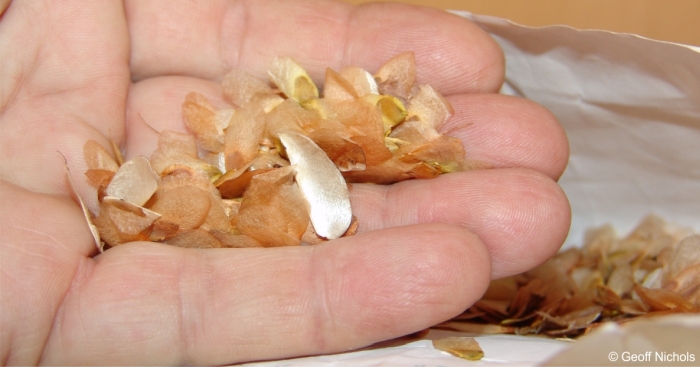
Growing Dioscorea sylvatica
Grow
Dioscorea sylvatica can be easily propagated from seed. Before sowing the seeds they must be rubbed together to get rid of the papery wing attached to the seeds. The seeds can be sown in a normal seedling mix and germination should occur within 10 days. Grow the plant in well-drained, humus-rich soil. Since these plants are climbers, the tendrils will need a supporting mini-trellis to climb over. If the plants are not given this support, they tend to intertwine making it difficult to separate the plants when re-potting. The tuber forms under the ground and will grow faster when kept underground for a few years. Dioscorea sylvatica prefers light shade, however the tuber should be kept in full shade. It needs regular watering during the growing season and no watering when the tuber is dormant. Watering can recommence once the plant has shown signs of producing a fresh shoot. The plants survive the dry season by means of a large underground tuber that develops very slowly.
References
- Beinart, W. & Beinart, R. 2019: From Elephant’s Foot to Cortisone: Boots Pure Drug Company and Dioscorea Sylvatica in South Africa, c. 1950–1963, South African Historical Journal, DOI: 10.1080/02582473.2019.1668837.
- Blunden, G., Hardman, R. & Hind, F.J. 1971. The comparative morphology and anatomy of Dioscorea sylvatica Eckl. from Natal and the Transvaal. Botanical Journal of the Linnean Society 64(4): 431-446.
- Cogne, A.L. 2002. Phytochemical investigation of plants used in African traditional medicine: Dioscorea sylvatica, Urginea altissima, Jamesbrittenia fodina and Jamesbrittenia elegantissima. Doctoral dissertation, Université de Lausanne.
- Cogne, A.L., Marston, A., Mavi, S. & Hostettmann, K. 2001. Study of two plants used in traditional medicine in Zimbabwe for skin problems and rheumatism: Dioscorea sylvatica and Urginea altissima. Journal of Ethnopharmacology 75(1):51-53.
- Diederichs, N. (Ed.). 2012. Commercialising medicinal plants: a southern African guide. African Sun Media.
- Hills, R., Bachman, S., Forest, F., Moat, J. & Wilkin, P. 2019. Incorporating evolutionary history into conservation assessments of a highly threatened group of species, South African Dioscorea (Dioscoreaceae). South African Journal of Botany 123:296–307.
- Maroyi, A. 2021. Evaluation of medicinal uses, phytochemistry, and pharmalogical properties of Dioscorea sylvatica. International Journal of Scientific & Technology Research 10(6): 99-105.
- Maurin, O., Muasya, A.M., Catalan, P., Shongwe, E.Z., Viruel, J., Wilkin, P. & Van Der Bank, M. 2016. Diversification into novel habitats in the Africa clade of Dioscorea: erect habit and elephant’s foot tubers. BMC Evolutionary Biology 16(1):174-177.
- Nichols, G. 2005. Growing rare plants: a practical handbook on propagating the threatened plants of southern Africa. Southern African Botanical Diversity Network Report No. 36.
- Pooley, E. 2005. A field guide to wild flowers KwaZulu-Natal and the eastern region. The Flora Publications Trust, Durban.
- Raimondo, D. 2019-03. Observation of Dioscorea sylvatica, Vhembe District. iNaturalist. Online. https://www.inaturalist.org/observations/20912645.
- Schols, P., Furness, C. A., Wilkin, P., Huysmans, S. & Smets, E. 2001. Morphology of pollen and orbicules in some Dioscorea species and its systematic implications. Botanical Journal of the Linnean Society 136(3):295-311.
- Smith, G.F., Crouch, N.R. & Figueiredo, E. 2017. Field guide to succulents in southern Africa. Struik Nature, Cape Town.
- Swartz, P. 2000. Woude en hul omkringende grasvelde. Veld & Flora 86(1): 30-32.
- Van Berkel, N. 2019-03. Observation of Dioscorea sylvatica, Eden District. iNaturalist. Online. https://www.inaturalist.org/observations/21078932.
- Van Berkel, N. 2019-03. Observation of Dioscorea sylvatica, Garden Route District Municipality. iNaturalist. Online. https://www.inaturalist.org/observations/21078934.
- Wilkin, P. 2001. Dioscoreaceae of south-central Africa. Kew Bulletin 56(2):361-404.
- Wilkin, P. et al. 2005. A plastid gene phylogeny of the yam genus, Dioscorea: roots, fruits and Madagascar. Systematic Botany 30(4): 736-749.
- Williams, V.L., Raimondo, D., Crouch, N.R., Cunningham, A.B., Scott-Shaw, C.R., Lötter, M. & Ngwenya, A.M. 2008. Dioscorea sylvatica Eckl. National Assessment: Red List of South African Plants version 2020.1. Accessed on 2023/03/09.
Credits
Lufuno Nenungwi and Bontle Matetoane
Free State National Botanical Garden
August 2023
Acknowledgements: images by Domitilla Raimondo, Nicola van Berkel and Geoff Nichols.
Plant Attributes:
Plant Type: Climber
SA Distribution: Eastern Cape, Free State, Gauteng, KwaZulu-Natal, Limpopo, Mpumalanga, Western Cape
Soil type: Loam
Flowering season: Early Summer
PH: Acid, Neutral
Flower colour: Green, White, Cream
Aspect: Full Sun, Morning Sun (Semi Shade), Afternoon Sun (Semi Shade)
Gardening skill: Average
Special Features:
Horticultural zones









Rate this article
Article well written and informative
Rate this plant
Is this an interesting plant?
Login to add your Comment
Back to topNot registered yet? Click here to register.